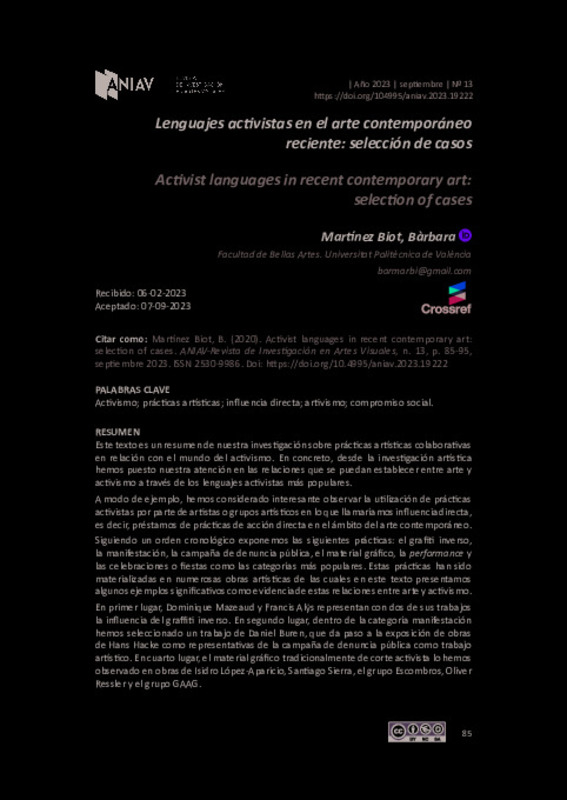|
Resumen:
|
[EN] This text is a summary of our research on collaborative artistic practices in relation to the world of activism. Specifically, from artistic research we have focused our attention on the relationships that can be ...[+]
[EN] This text is a summary of our research on collaborative artistic practices in relation to the world of activism. Specifically, from artistic research we have focused our attention on the relationships that can be established between art and activism through the most popular activist languages.
As an example, we have considered it interesting to observe the use of activist practices by artists or artistic groups in what we would call direct influence, that is, borrowing from direct action practices in the field of contemporary art.
Following a chronological order, we expose the following practices: reverse graffiti, demonstration, public denunciation campaign, graphic material, performance, and celebrations or parties as the most popular categories. These practices have been materialized in numerous artistic works of which in this text we present some significant examples as evidence of these relationships between art and activism.
First of all, Dominique Mazeaud and Francis Alÿs represent with two of their works the influence of reverse graffiti. Secondly, within the manifestation category we have selected a work by Daniel Buren, which leads to the exhibition of works by Hans Hacke as representative of the public denunciation campaign as artistic work. Fourthly, we have observed traditionally activist graphic material in works by Isidro López-Aparicio, Santiago Sierra, the Escombros group, Oliver Ressler and the GAAG group.
Finally, the performance, parodies and parties categories will be represented by the group The Waitresses, Regina José Galindo, Coco Fusco and Guillermo Gómez-Peña and Antoni Miralda.
These artistic practices are shown here read from the most outstanding activist languages, reflecting the direct and indirect influences that cross these two fields that are so frequently related.
[-]
[ES] Este texto es un resumen de nuestra investigación sobre prácticas artísticas colaborativas en relación con el mundo del activismo. En concreto, desde la investigación artística hemos puesto nuestra atención en las ...[+]
[ES] Este texto es un resumen de nuestra investigación sobre prácticas artísticas colaborativas en relación con el mundo del activismo. En concreto, desde la investigación artística hemos puesto nuestra atención en las relaciones que se puedan establecer entre arte y activismo a través de los lenguajes activistas más populares.
A modo de ejemplo, hemos considerado interesante observar la utilización de prácticas activistas por parte de artistas o grupos artísticos en lo que llamaríamos influencia directa, es decir, préstamos de prácticas de acción directa en el ámbito del arte contemporáneo.
Siguiendo un orden cronológico exponemos las siguientes prácticas: el grafiti inverso, la manifestación, la campaña de denuncia pública, el material gráfico, la performance y las celebraciones o fiestas como las categorías más populares. Estas prácticas han sido materializadas en numerosas obras artísticas de las cuales en este texto presentamos algunos ejemplos significativos como evidencia de estas relaciones entre arte y activismo.
En primer lugar, Dominique Mazeaud y Francis Alÿs representan con dos de sus trabajos la influencia del graffiti inverso. En segundo lugar, dentro de la categoría manifestación hemos seleccionado un trabajo de Daniel Buren, que da paso a la exposición de obras de Hans Hacke como representativas de la campaña de denuncia pública como trabajo artístico. En cuarto lugar, el material gráfico tradicionalmente de corte activista lo hemos observado en obras de Isidro López-Aparicio, Santiago Sierra, el grupo Escombros, Oliver Ressler y el grupo GAAG.
Finalmente, las categorías performance, parodias y fiestas estarán representadas por el grupo The Waitresses, Regina José Galindo, Coco Fusco y Guillermo Gómez-Peña y Antoni Miralda.
Estas prácticas artísticas se muestran aquí leídas desde los lenguajes activistas más destacados reflejando las influencias directas e indirectas que atraviesan estos dos ámbitos tan frecuentemente relacionados
[-]
|







![HTML file [HTML]](/themes/UPV/images/html.png)

